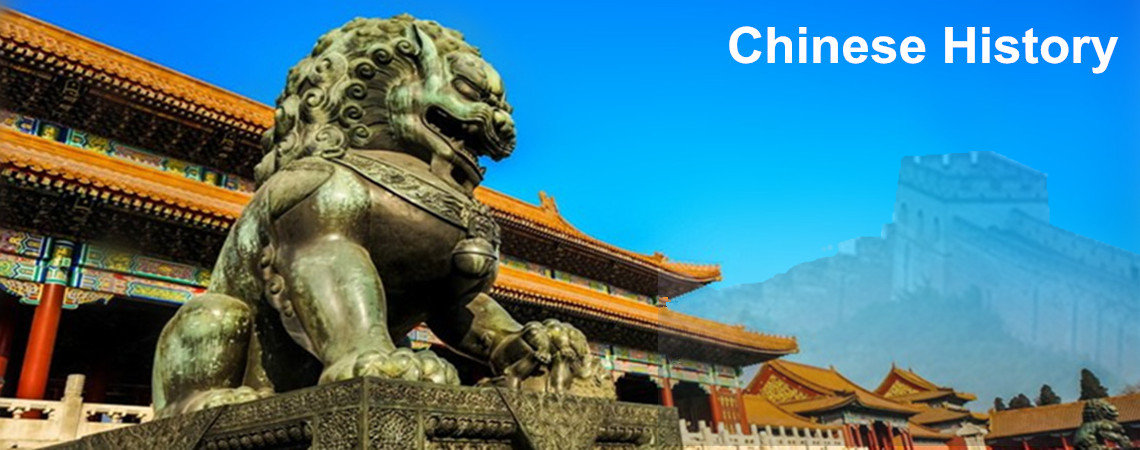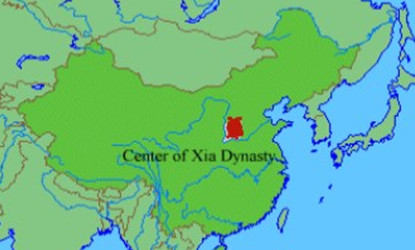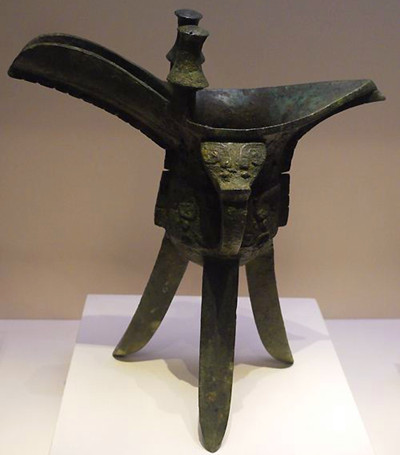
Xia Dynasty (2170BC-1766BC)
Facts of Xia Dynasty
Duration: 2170 B.C-1600 B.C
Capital: Yangcheng,Yangdi in Henan Province
Emperors: 17 emperors, including Qi, Tai Kang, Shao Kang Zhongxing, Kong Jia and Jie,etc
Replaced by: Shang Dynasty
Intruduction to the Xia Dynasty
During the 21st century BC, Yu succeeded in controlling the floods of the Yellow River and Shun the leader
 abdicated and made Yu the head of the tribal federation along the Yellow River watershed. After Yu's death, his son Qi, inherited the position from his father, abolishing the abdication system where the best man ruled and established the first slave dynasty, the Xia Dynasty in Chinese history. from Yu to Jie, emperors of Xia Dynasty ruled the Yellow River Watershed area of China for over 400 years, through 17 kings of 14 generations. Originally, the capital was in Yangcheng laid on the Mt. Songshan, Dengfeng County of Henan Province, and later it was moved to Yangdi (Yuzhou City, Henan Province today).
abdicated and made Yu the head of the tribal federation along the Yellow River watershed. After Yu's death, his son Qi, inherited the position from his father, abolishing the abdication system where the best man ruled and established the first slave dynasty, the Xia Dynasty in Chinese history. from Yu to Jie, emperors of Xia Dynasty ruled the Yellow River Watershed area of China for over 400 years, through 17 kings of 14 generations. Originally, the capital was in Yangcheng laid on the Mt. Songshan, Dengfeng County of Henan Province, and later it was moved to Yangdi (Yuzhou City, Henan Province today).After ascending to the throne, Qi feasted leaders of all parts of the country at Juntai lying in Yuzhou City, Hennan Province, in the hope of establishing his rulership. Dissatisfied with Qi's destroying of the abdication system, the leader of the Youhu tribe refused to attend the dinner. Qi went on a punitive expedition against the Youhu tribe and defeating them helped him to consolidate the regime of the Xia Dynasty.
Qi addicted himself to drinking and entertainment, and died after ten years as sovereign. After Qi's death, his son, Taikang, took over his position. Taikang was slovenly with the political affairs, and indulged in debauchery. As a result, Houyi, leader of the Youqiong tribe, seized the opportunity and captured the regime. Houyi also delighted in hunting and playing, and finally was killed by his ministers. Following the death of Houyi, the Xia Dynasty floundered for 40 years. Eventually, Shaokang, a great grandson of Taikang, resumed as sovereign of the Xia Dynasty with the help of the Youhu tribe. Thereafter, the Xia Dynasty experienced rule by eight wise emperors's during which the society was steady, the economy was prosperous, and people lived a peaceful and happy life.
During the prosperous times, the territory of the Xia Dynasty spread to the west of Henen Province and the south of the Shanxi Province. In the east, it reached to the juncture of Henan, Shandong and Hebei Provinces; it started from Hubei Province in the south and ended in Hebei Province in the north. During that period Xia's rule extended to the north and south of the Yellow River even to the Yangtze River watershed.
Following the rule of Emperor Kongjia (1789 -1758 BC), the Xia Dynasty gradually went into decline again. Kangjia paid little attention to state affairs, thus class contradiction became very sharp, in addition to the continuous foreign aggression. The last emperor, Jie(1728-1675 BC) was very extravagant and dissipated. Jie constructed a palace for his favorite Concubine Meixi, drank and made entertainment with her day and night, in spite of the hardship of the common people. The loyal ministers who admonished him were all killed, thus vassals on all sides betrayed Jie. Tang, the leader of the Shang tribe in the East, led his army in a crusaded against Jie. With the summons 'kismet' Tang won the support of most common people and defeated Jie. Jie escaped to Nanchao (south west of the Chao County, Anhui Province today) and died there in the end, which signaled the end of the Xia Dynasty.
Science and Technology in the Xia Dynasty
 During the Xia Dynasty, agriculture progressed. There is also a legend has it that Di, a minister of Yu, began to make wine. In addition to adapting to the production needs of agriculture, the traditional Chinese lunar calendar was created which is the earliest calendar in China. People confirmed the months according to the handle of the Plough (the Big Dipper), and then recorded the star like images, weather, object-image transformations and the corresponding farming affairs. In stockbreeding, a large number of experiments were engaged in, and some tribes even specialized in raising domestic animals. Horse breeding was given great importance during this period.
During the Xia Dynasty, agriculture progressed. There is also a legend has it that Di, a minister of Yu, began to make wine. In addition to adapting to the production needs of agriculture, the traditional Chinese lunar calendar was created which is the earliest calendar in China. People confirmed the months according to the handle of the Plough (the Big Dipper), and then recorded the star like images, weather, object-image transformations and the corresponding farming affairs. In stockbreeding, a large number of experiments were engaged in, and some tribes even specialized in raising domestic animals. Horse breeding was given great importance during this period.
Pottery and bronze making were also developed, but they were primitive, with simple carving lines. Some of the pottery and bronze objects then were just drawn with some round spots on them, without patterns. The other characteristic is the similarity of design between the pottery and bronze objects.
Stone tools were still the main tools of the society. Primitive vehicles first appeared in the capital city of the Xia Dynasty, although it is not known whether they were rickshaws or carriages.
Erlitou Culture in the Xia Dynasty
Through years' of investigation and excavation, a culture between the Longshan Culture and the Shang Culture has been discovered in the west part of Henan Province and the south part of Shanxi Province. Distinctive relics discovered in Yanshi City, Henan Province were named Erlitou, which led to distinguishing the find as 'Erlitou Culture'.
Erlitou Culture has been dated to about 1,900 BC, during the rule of the Xia Dynasty. Because there is little recorded literature passed down about the Xia Dynasty, the large sized Erlitou palaces, distinctive tombs, pottery and bronze objects provide rich references for archaeologists.







 Ask Questions ?
Ask Questions ?